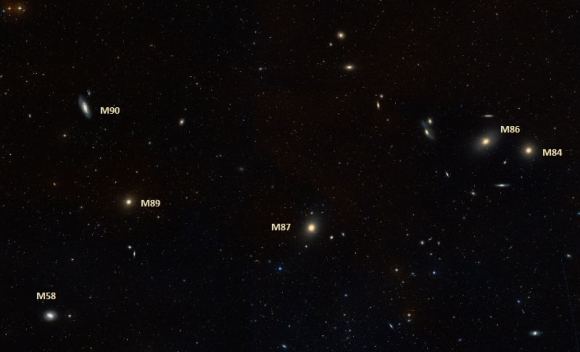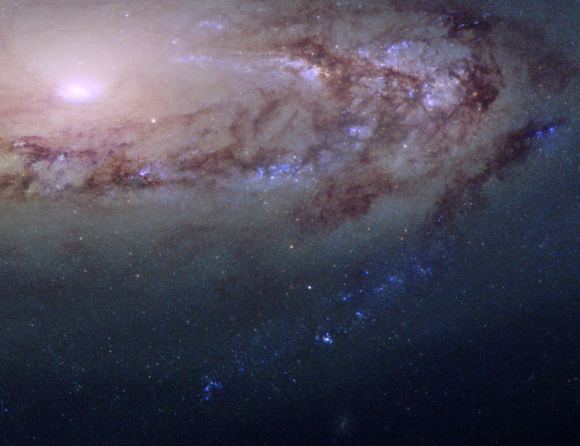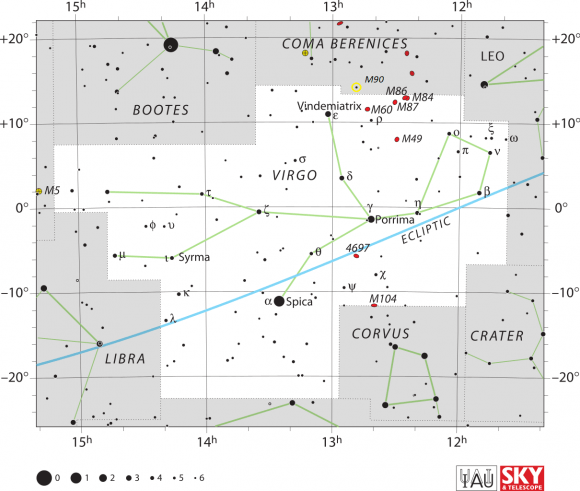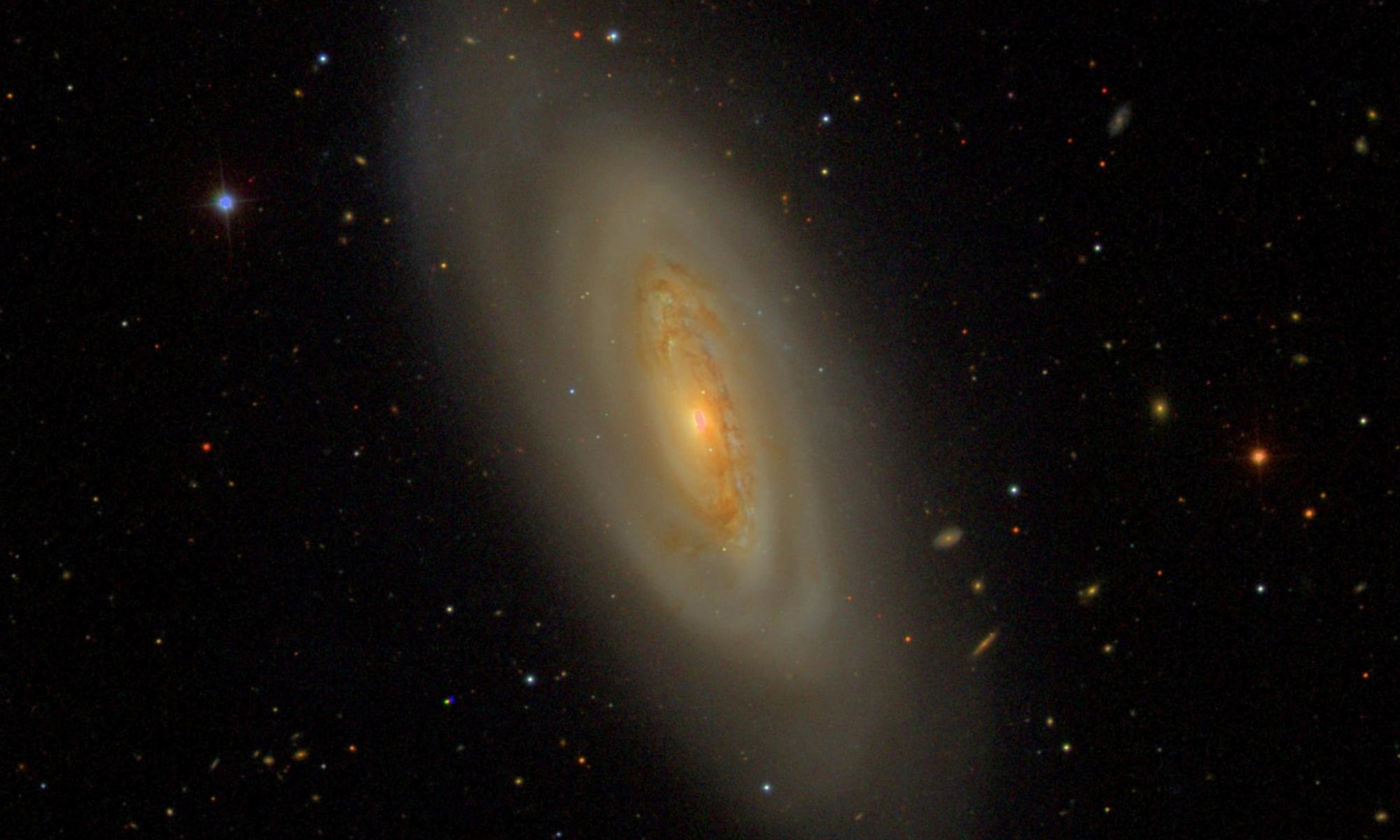Welcome back to Messier Monday! Today, we continue in our tribute to our dear friend, Tammy Plotner, by looking at the approaching spiral galaxy known as Messier 90!
During the 18th century, famed French astronomer Charles Messier noticed the presence of several “nebulous objects” while surveying the night sky. Originally mistaking these objects for comets, he began to catalog them so that others would not make the same mistake. Today, the resulting list (known as the Messier Catalog) includes over 100 objects and is one of the most influential catalogs of Deep Space Objects.
One of these objects is the intermediate spiral galaxy known as Messier 90, which is located about 60 million light-years away in the constellation Virgo – making it part of the Virgo Cluster. Unlike most galaxies in the local group, Messier 90 is one of the few that have been found to be slowly moving closer the Milky Way (the others being the Andromeda and the Triangulum galaxy).
What You Are Looking At:
As one of the larger spiral galaxies in the Virgo Cluster, M90 would at first appear to be a galaxy that has halted star formation. Its low density and tightly wound spiral arms all point to an island universe about to undergo metamorphosis. Yet, deep in its heart, M90 just isn’t finished yet. As S. Rys (et al) said in 2007 study:
“NGC4569 is a bright spiral (Sb) galaxy located only 0.5Mpc from the Virgo Cluster center, known for its compact starburst in the core and a giant (8 kpc) outflow of Ha emitting gas perpendicular to the galaxy disk. Our recent polarimetric radio continuum observations with the Effelsberg telescope at 4.85 GHz and 8.35 GHz reveal huge magnetized lobes, even extending 24 kpc from the galactic plane. This is the first time that such huge radio continuum lobes are observed in a cluster spiral galaxy. In contrast to the radio emission the X-rays do not show similarly large extensions on both sides of the galactic disk. However, stronger X-ray emission is visible close to the disk on its western part, and corresponds to the enhanced radio and Ha emission there. The extension is broad, thus more typical for a wide-spread starburst than for a more collimated ionisation cone from an AGN. The less extended X-ray soft component is also visible to the SW direction from the disk. The inspection of radio emission from the galaxy lobes indicates that indeed the lobes cannot be powered by an AGN but are probably caused by a nuclear starburst and superwind-type outflows which occurred ? 30 Myr ago. This is supported by estimates of the combined magnetic and cosmic-ray pressure inside the lobes from our radio data. The Ha spur and associated soft X-ray emission on the western part of the disk could be a recent example of such numerous events in the past.”

So what else can account for starburst activity in a changing galaxy? Try gas. As Jerry Kenney (et al) indicated in a 2004 study:
“One of the clearest cases is the highly inclined Virgo galaxy NGC 4522, which has a normal stellar disk but a truncated gas disk, and lots of extraplanar gas right next to the gas truncation radius in the disk. Unusually strong HI, H and radio continuum emission are all detected from the extraplanar gas. The radio continuum polarized ux and spectral index peak on the side opposite the extraplanar gas, suggesting ongoing pressure by the ICM. Four other HI-deficient edge-on Virgo spirals show evidence of extraplanar ISM gas or exhibit asymmetries in their disk HI distributions, but contain much less extraplanar HI than NGC 4522. Comparison with recent simulations suggests this difference may be evolutionary, with large surface densities of extraplanar gas observed only in early phases of an ICM-ISM interaction. An anomalous arm of HII regions, possibly extraplanar, emerges from the edge of a truncated H disk. This resembles the arms seen in simulations which are formed by the combined effects of wind pressure plus rotation. An extended nebulosity near the minor axis, also in the NW, is interpreted as a starburst out flow bubble disturbed by ICM wind pressure.”
So why does it fascinate us so much? Astronomer Bill Keel arguably summarized it best:
“The interest in starburst galaxies has been brought on by wondering how some galaxies, and often very small regions in their nuclei, manage to convert so much gas effectively into stars in a very short time. Often there’s plenty of molecular gas as judged from CO emission, so it’s not a fuelling question so much as a collection puzzle. How can so much molecular gas collect without already forning stars on the way (the analogous issue for fissile material is known as the fizzle problem). The statistics of starbursts may hold a clue – starbursts are notably more common in interacting and merging systems than in more isolated galaxies. While this does not mean that more of them occur in interactions (simply because only about 10% of galaxies are in bound pairs), it does suggest that the conditions are far easier to attain during interactions and mergers. A number of indicators of star formation tell similar stories here. The majority of spirals in pairs experience an increase in SFR typically 30%, while a few experience increases of an order of magnitude. The burst is often confined to a few hundred parsecs near the nucleus, although disk-wide bursts are common. This preference for disturbed galaxies has led to a range of speculations on what causes the enhancements (and thus at least contributes to starbursts).”
“The high energy densities, both in starlight and mechanical input through stellar winds and supernovae, can actually unbind the ISM from starburst galaxies. The heated ISM can set up a global (or super) wind, detetcable in optical line emission, scattered starlight, and soft X-rays (most prominently from the interface at the edge of the roughly conical outflow). Most of the escaping matter can be so hot that we don’t even see it in X-rays, cooling only at the interface with less disturbed ISM. This wind may be important in forming early-type galaxies, since one has to sweep the gas out of a merger product if it’s going to end up as an elliptical. Something like this seems to have happened early in the history of clusters and groups, since intracluster X-ray gas shows chemical traces of having been processed by massive stars.”

History of Observation:
M90 was one of 7 members of the Virgo Galaxy cluster discovered by Charles Messier on the night of March 18, 1781. In his notes he writes: “Nebula without star, in Virgo: its light is as faint as the preceding, No. 89.”
By the time Sir William Herschel made it to Messier’s catalog number 90, he’s enjoying a moonlit night and – at least by what records we have – never returns again. Thankfully Admiral Smyth came to the rescue!
“This is a wonderful nebulous region, and the diffused matter occupies an extensive space, in which several of the finest objects of Messier and the Herschels will readily be picked up by the keen observer in extraordinary proximity. The following diagram exhibits the local disposition of the immense nebulous neighbors north [actually south] of 88 Messier; they being preceded by M., No. 84 and followed by M. 58, 89, 90 and 91, in the same zone; thus describing a spot only 2 deg 1/2 from north to south, and 3 deg from east to west, as the micrometer shows it. And it will be convenient to keep in mind, that the situation of the extraordinary conglomerate of nebulae and compressed spherical clusters which crowd the Virgin’s left wing and shoulder, is pretty well pointed out to the practised naked eye by Epsilon, Delta, Gamma, Eta, and Beta Virginis forming a semi-circle to the east, whilst due north of the last-mentioned star, Beta Leonis marks the north-west boundary. Reasoning upon the Herschelian principle, this may reverently be assumed as the thinnest or shallowest part of our firmament; and the vast laboratory of the segregating mechanism by which compression and insulation are ripened, in the course of unfathomed ages. The theme, however imaginative, is solemn and sublime.”
Locating Messier 90:
Begin with the base M84/M86 pairing located almost exactly mid-way between Beta Leonis (Denebola) and Epsilon Virginis (Vindemiatrix). The above map shows quite some distance between the galaxies, but by running a “grid” pattern, you can starhop the Virgo galaxy field with ease. Once you have M84/M86 in sight, move one low power eyepiece field east and hop north less than and eyepiece field for M87.

Now you understand how Charles Messier ran his sky patterns! Continue north for 1 or two eyepiece fields and then shift east by one. This should bring you to M88. Now shift one more field east and drop south between 1 to 2 fields for M89. Your next hop is also an eyepiece field east and then 1 north for M90. In the eyepiece, M90 will appear as a very faint round haze, that’s very even in appearance. Because M90 nears magnitude 10, it will require a dark night.
From the sublime to the ridiculous… from one galaxy hop to the next in a rich field. Enjoy your Virgo Quest!
Object Name: Messier 90
Alternative Designations: M90, NGC 4569
Object Type: Type Sb Barred Spiral Galaxy
Constellation: Virgo
Right Ascension: 12 : 36.8 (h:m)
Declination: +13 : 10 (deg:m)
Distance: 60000 (kly)
Visual Brightness: 9.5 (mag)
Apparent Dimension: 9.5×4.5 (arc min)
We have written many interesting articles about Messier Objects and globular clusters here at Universe Today. Here’s Tammy Plotner’s Introduction to the Messier Objects, M1 – The Crab Nebula, Observing Spotlight – Whatever Happened to Messier 71?, and David Dickison’s articles on the 2013 and 2014 Messier Marathons.
Be sure to check out our complete Messier Catalog. And for more information, check out the SEDS Messier Database.
Sources:

